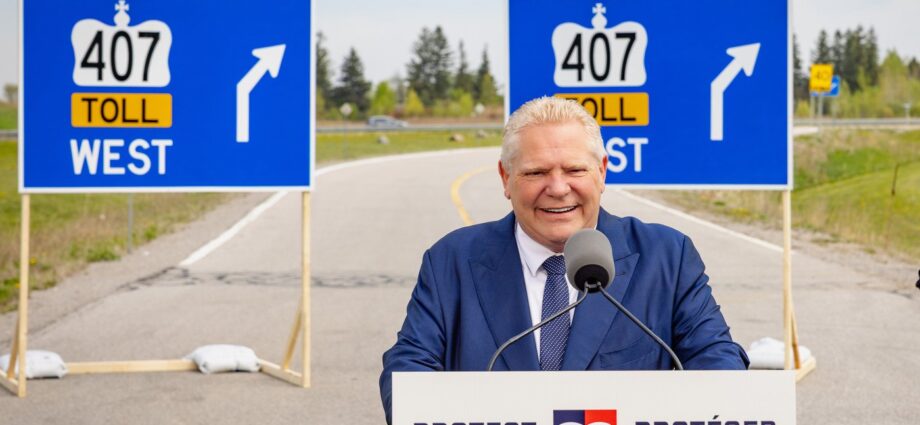
By Abdul Matin Sarfraz / Canada’s National Observer / Local Journalism Initiative
May 14, 2025
Premier Doug Ford is selling car-friendly tax and fee cuts announced on Tuesday as a win for Ontario drivers — but experts warn the lost revenue could drain funding for public transit, shift costs to taxpayers and set back climate goals by encouraging more driving.
Introducing his government’s new legislation “to help lower costs and fight gridlock,” Ford said the gas tax cut will save the average household around $115 annually, while removing tolls on the provincially-owned section of Highway 407 East starting in June could save some commuters more than $7,000 a year.
“It’s frustrating to hear this kind of policy announcement, which we know is counterproductive,” said Albert Koehl, an environmental lawyer and author of Wheeling Through Toronto. “Premier Ford talks a lot about reducing congestion, yet he continues to pursue the same failed policies of the past.”
Koehl argues the province is undermining its own transit investments by making driving cheaper and more attractive, which evidence shows increases traffic. “This is a government using public money against the public interest.”
The cuts — first introduced in 2022 and set to expire in June — reduce the gasoline tax by 5.7 cents per litre and the diesel fuel tax by 5.3 cents per litre.
Ontario has not had its own carbon-pricing plan since the Ford government scrapped cap-and-trade in 2018. The province currently falls under the federal carbon tax, which Prime Minister Mark Carney removed. That move, along with Ford’s gas tax cut, further distances Ontario from any pricing on pollution.
Koehl also raised concerns about the equity of the move, suggesting that the gas tax cuts and toll rollbacks disproportionately benefit drivers who are more likely to be higher-income. Meanwhile, those who rely on public transit — often lower-income residents — gain little from the changes.
The province currently falls under the federal carbon tax, which Prime Minister Mark Carney removed. That move, along with Ford’s gas tax cut, further distances Ontario from any pricing on pollution.
Ontario’s road transportation sector already accounts for 26 per cent of the province’s emissions.
Evidence from other countries supports experts’ concerns about the consequences of cutting fuel taxes, which tend to increase driving. In Germany’s 2022 experiment, the government lowered fuel taxes while introducing a discounted public transit pass. Although transit use increased, researchers found that the cheaper fuel led to a significant rise in driving — offsetting some of the environmental benefits. Similarly, a 2024 UK study found that fuel duty cuts primarily benefitted higher-income drivers and drained funds that could have been invested in public transit and sustainable infrastructure.
Matti Siemiatycki, a University of Toronto professor and director of its Infrastructure Institute, says the policy will increase traffic and emissions while deepening Ontario’s deficit.
“When you make driving cheaper, more people do it — and they drive farther,” Siemiatycki said. “The short-term savings at the pump will be paid for in longer commutes, more congestion, and higher emissions.”
Siemiatycki told Canada’s National Observer the province is shifting costs from drivers onto all taxpayers. The eastern extension of Highway 407 is one example — its long-term capital and operating costs were once covered by tolls, but will now be paid by all Ontarians, he added.
Although the government is investing in transit — particularly rapid transit — Siemiatycki pointed out that these projects take years to complete. In the meantime, the province has done little to fill the gap with cost-effective measures, like dedicated bus lanes or express services.
Siemiatycki said the lost revenue from tolls and fuel taxes will still need to be made up elsewhere. Ultimately, he argued, the province’s financial obligations won’t disappear, so with the province already running a deficit, the shortfall will likely be covered through general taxation or cuts.
Ontario Green Party Leader Mike Schreiner also questioned the province’s transportation priorities, suggesting that if the government truly wanted to reduce congestion, it should focus on subsidizing truck tolls on Highway 407 to shift freight traffic off the overcrowded 401.
“The problem with cutting the gas tax is that it takes money away from funding transit operations in communities across the province,” Schreiner said. “That makes it harder to provide affordable and reliable public transit. At a time when people are facing real affordability challenges, it would be far more helpful to invest in accessible, affordable transit options.”
But doing that requires provincial investment in transit operating costs — removing gas tax revenue makes it harder to do that, he added.
Schreiner said the Ford government’s pattern of investment reveals a clear preference for cars over people.
“They continue to invest in highways and driving infrastructure, while neglecting more affordable, healthy, and sustainable options like public transit and bike lanes,” he said.
When it comes to sustainable solutions, Tim Gray, executive director of Environmental Defence, said the province should prioritize expanding public transit, especially within and between cities in the Greater Golden Horseshoe region of southern Ontario.
“We should be prioritizing buses in urban spaces, like creating dedicated bus lanes,” Gray said. “The provincial government should be supporting public transit operations, as well as the construction of new lines.”
The government should be supporting housing construction within cities, instead of pushing development onto distant farmland, he added.
Subscribe to our newsletter.
Abdul Matin Sarfraz / Canada’s National Observer / Local Journalism Initiative

